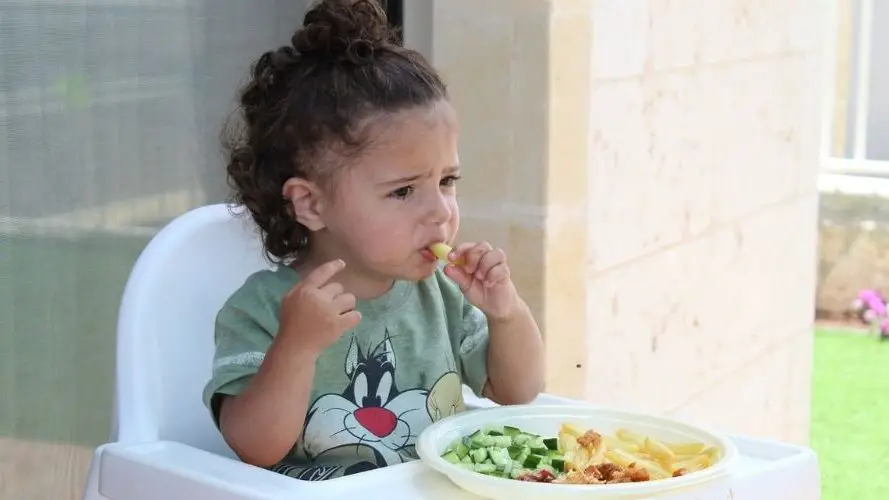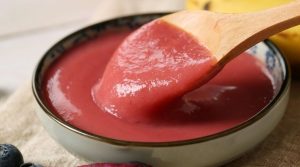As parenting trends and new methods take over, it can be easy to feel like choosing the old-school variety is the “bad” choice. We’re here to tell you that you don’t actually have to choose one or the other. That it’s not new vs old, good vs bad, or baby-led weaning vs purees.
Instead, you can try both, follow your baby’s lead, and figure out what works best for your little family. When in doubt, remember the cardinal rule of feeding in the first year of life (that often gets buried under all the noise): fed is best. Yes, really!
What is baby-led weaning?
Baby-led weaning (BLW) is the process of introducing your child to solids without pureeing the food or purchasing traditional baby food. Instead, you can cut up bite-size pieces and strips of what everyone else is eating. While it’s slow going at first, your baby will soon get the hang of picking up their own food and getting it into their mouth.
BLW promotes independence, hand-eye coordination, and everything is set completely at their pace. They’re able to choose what they eat, feed themselves, and stop when they’re full, eating intuitively from day one. Busy moms or parents with multiple children typically appreciate not having to sit and spoon feed, although it’s important to keep an eye on the baby at all times while they’re eating.
BLW doesn’t have to be all-or-nothing, and it often happens naturally with second or third children as parents quickly realize that cutting up another plate is easier than spoon-feeding. However, BLW is not for everybody. Perhaps you enjoy the time spent spoon-feeding your baby, have a deep fear of your child choking or gagging, or simply prefer traditional feeding methods.
Before starting solids, make sure that your child is ready, typically around 6 months. They should be able to sit up in their high chair, have good head control, have doubled their birth weight, and seem interested in food, opening their mouth or reaching for it. 1Purees vs Baby-Led Weaning?
childrensmd.org
Related: The 7 Best Baby Spoons to Buy in 2021
Pros of purees
- You don’t have to worry about choking. I know a few moms who have a serious fear of their child choking, and for this reason, baby-led weaning would have been extremely stressful and anxiety-inducing.
- You know exactly how much they ate. When babies feed themselves, it’s hard to track how much food made it into their mouths.
- Can be less of a mess. Although babies are pretty good at making a disaster out of purees as well.
- Simpler when leaving the baby in someone else’s care. It can be easier to drop off a jar or two of baby food vs cutting up a meal. It helps to keep their favorites cut up and ready to go in the fridge.
- Older or more traditional caregivers may be more comfortable with it. When leaving your baby with grandma or another caregiver, they may be used to spoon-feeding with purees.
Cons of purees
- Purees can be less intuitive. Depending on who’s feeding the baby, adults may keep going until the jar is finished.
- You can’t eat at the same time as your baby. It’s hard (but possible) to eat while spoon-feeding your baby. BLW helps promote family mealtime, where everyone sits down at the same time and eats the same meal.
- When homemade, it can be time-consuming.
- Your baby is only being exposed to one texture and is not learning to feed themselves.
Related: The Best Vegetables for Babies by Stage
Pros of baby-led weaning
- Perhaps the biggest advantage of BLW is that it promotes healthy eating habits, self-regulation, and listening to fullness cues from the get-go.
- Baby is completely in charge of what they eat, their pace, and how much they eat.
- Prep can be simple if you’re all eating the same thing. BLW may even prompt you to eat a little healthier.
- Offering different textures and tastes with each meal encourages more adventurous eating.
- It’s a sensory experience, including touch, taste, smell, and sight.
- BLW promotes hand-eye coordination. Watching them finally figure out how to get the food into their mouth feels like such a victory for you both.
Cons of baby-led weaning
- If you’re not eating healthy foods at a particular meal, creating a separate meal can be time-consuming. Prepping baby-friendly food ahead of time can ensure you always have healthy options available, but that’s also time-consuming.
- Some parents and caregivers have a fear of choking and gagging if not done properly.
- It’s hard to know how much food they’re getting- especially if you have a dog!
- Wasted food on the floor and falling into the high chair.
- BLW can make for long meals. For some, it’s an advantage to keep the baby happily distracted, but if you’re short on time, not so much.
Related: When Do Babies Start Eating Baby Food?
A combined approach
Luckily for you, you don’t have to pick one or the other. Many doctors recommend a combined approach, which parents often fall into naturally. Not only that, but doctors want you to know that BLW does not mean that you should skip entirely over purees. It’s an important texture (think soups and yogurt), and if babies aren’t introduced to it, they may not like it later. 2Do I Have to Choose Between Baby-Led Weaning and Purees?
malinamalkani.com
You can start with purees if you like, slowly adding in cut-up pieces of food as your baby gains interest in the foods around them. You can spoon-feed when you’re in a hurry, or bring purees when your mom is watching the baby. If you worry about how much they’re getting, offer finger foods first and supplement with purees.
What is responsive feeding?
If you like the idea of intuitive eating and self-regulation, make sure to practice responsive feeding when spoon-feeding. Responsive feeding is simple, and I suspect most of it practice it to begin with. Watch your child for signs of hunger, allow them to have more when they want more, and stop when they’re full.
Avoid force-feeding purees until the bowl or jar is finished, feeding the baby too quickly, or ignoring their fullness signs. Signs of hunger include staring at, pointing at, or reaching for food, opening their mouths, getting excited when they see food, or crying. When they’re full, they may turn their head away, push the spoon or bowl away, become disinterested or distracted, or fuss. Their appetite and food intake will vary from day to day.
Safety tips for baby-led weaning
When done correctly, BLW is a safe and exploratory way to feed your baby. Some important tips to follow:
- Avoid hot dogs, seeds, popcorn, hard foods, hard candy, round foods like grapes and cherry tomatoes, and sticky or slippery foods
- No honey before the age of one (due to risk of botulism)
- No added sugar and salt
- Remove any peels and skins
- Choose soft foods that can be mashed up easily, foods that are cut up into strips or smaller pieces, or foods that will dissolve easily
- Go for iron-rich and high-calorie foods to meet their nutritional needs
- Introduce foods slowly so that you can isolate any food allergies
- Offer a sippy cup of water along with their meal
EDITOR’S NOTE
Gagging is very different from choking, and your baby likely will gag on both purees and finger foods. They are learning how to eat and move food around in their mouths, and their gag reflex is simply responding to the new tastes and textures. Babies gag easily, although it becomes less frequent as they get older and more used to eating solids.3Gagging: What You Need to Know About Feeding Baby
parents.com
Foods to try when introducing finger foods:
- Eggs- scrambled, hard-boiled, or quiche
- Cut up fruits like melon, banana, or roasted apple slices
- Steamed veggies like corn, peas, and broccoli
- Roasted sweet potatoes in 4-inch strips
- Mashed avocado on strips of toast
- Cut up chicken or fish
- Strips of pancakes or waffles
- Crackers
- Beans
- Pasta
Related: The 7 Best Baby Cereals to Buy in 2021
Before you go
Throughout our lives, food is a way to connect, show love, feel joy, and experience different cultures. From the start, food can be fun and intuitive, instead of stressful and forced. Luckily, this can be achieved with baby-led weaning, purees, or a combination of both. Let your baby take the lead, be flexible, and have fun!








